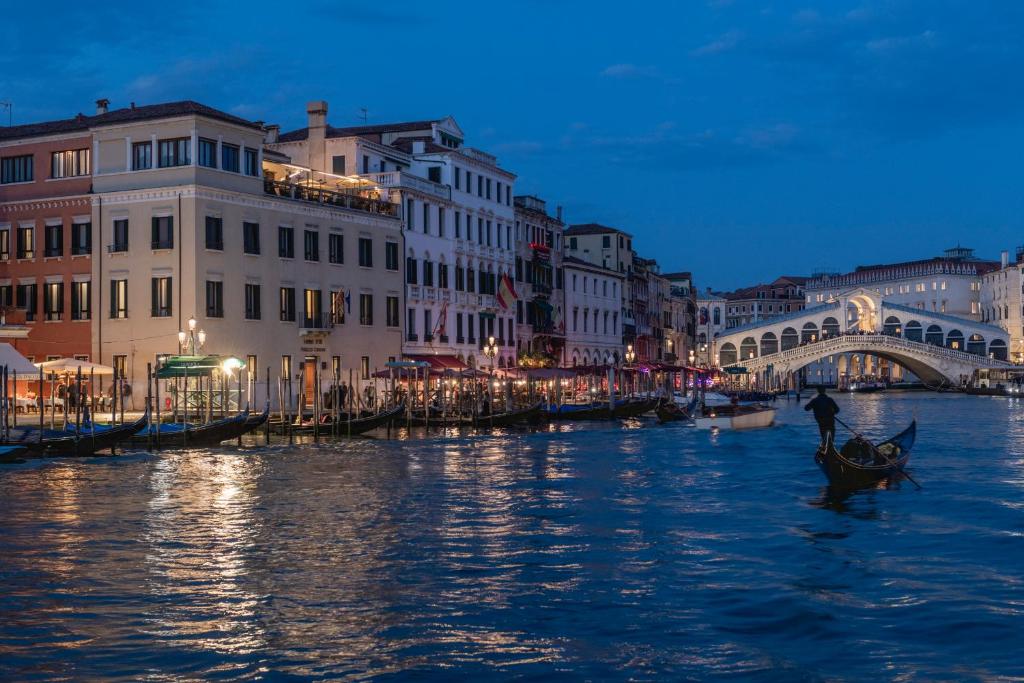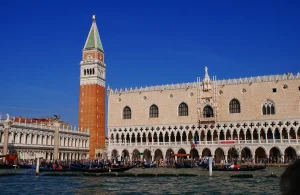How Deep Are the Canals in Venice? The Real Depth Behind the Floating City
When travelers arrive in Venice for the first time, one of the most common questions we hear is: “How deep are the canals?” After all, the city looks like it’s floating. Gondolas glide silently across the water, palaces seem to rise straight from the lagoon, and centuries of history shimmer on the surface. It feels almost magical — and many imagine the canals are bottomless, or at least deep enough to hide entire buildings.
The truth, however, is both surprising and fascinating. Venice stands not on water, but on engineering genius — a delicate balance between mud, wood, stone, and tide. Its lagoon is actually shallow, its canals carefully maintained, and its survival for more than 1,600 years nothing short of miraculous.
So let’s dive in (pun intended!) and explore what really lies beneath Venice’s rippling reflections — how deep the canals are, why that matters, and how this fragile ecosystem continues to keep the city alive.
🌊 1. The Myth of Venice “Floating on Water”
Venice is often described as a city that floats, but that’s more poetry than physics. The city was built on wooden piles driven deep into layers of clay and sand. These timber foundations, submerged and oxygen-starved, never rot — a natural miracle that has supported Venice’s marble palaces for centuries.
Its canals aren’t natural rivers; they were engineered and dredged by Venetians to create a functional water-based street system. So when you ask how deep the canals are, you’re really asking how this symphony of architecture, tides, and human ingenuity has worked for over a millennium.
Venice doesn’t float — it stands, gracefully, on millions of submerged pillars.
🚤 2. The Grand Canal — Venice’s Liquid Highway
The Grand Canal is Venice’s beating heart, curving through the city in a sinuous reverse “S.” At nearly 3.8 kilometers (2.4 miles) long, it’s the grand boulevard where palaces flaunt their façades and vaporetti weave between gondolas.
- Average depth: 1.5–5 meters (5–17 feet)
- Deepest points: around 5 meters, where larger boats pass
- Edges: shallower, especially near steps and mooring posts
That may sound surprisingly shallow, but it’s exactly right for Venice’s traffic — from private water taxis to gondolas and delivery boats. The canal has been dredged for centuries to prevent sediment from filling it in. Without constant care, it would slowly silt up and disappear beneath the tides.
When you glide past the Rialto Bridge or the Palazzo Barbaro, remember: you’re floating over just a few meters of water — and a thousand years of human history.
🏠 3. How Deep Are the Smaller Canals?
Venice has over 150 canals, each with its own rhythm and depth. Most are far shallower than the Grand Canal — intimate waterways for gondolas and small boats rather than vaporetto traffic.
- Average depth: 1.5–2 meters (5–6.5 feet)
- Quiet back canals: sometimes less than 1 meter (3 feet)
That’s why gondolas are flat-bottomed — they need only about 50 cm (20 inches) of water to move. This design lets gondoliers slip silently under bridges and into canals that would strand any other vessel. It’s also why motorboats are limited in many areas: a heavy hull or strong wake could easily damage the ancient canal walls.
🚣 Experience a Private Gondola Ride with Tour Leader Venice →
🌅 4. The Venice Lagoon — Shallow, Vast, and Alive
The Venetian Lagoon covers about 550 km² (212 mi²) — the largest in the Mediterranean — yet its average depth is just 1.2 meters (4 feet). Think of it as a vast, glittering puddle dotted with islands, sandbanks, and tidal channels.
- Average depth: 1.2 m (4 ft)
- Deepest natural channels: up to 12 m (40 ft)
This shallow water has always been both Venice’s shield and challenge. It kept pirates and navies at bay — large warships couldn’t enter — but it also demands endless vigilance. Without constant dredging, the lagoon would silt up; without tidal flow, it would stagnate.
Today, these same shallow depths continue to define life in Venice: fragile, adaptive, and utterly unique.
⚔️ 5. Shallow Waters, Strong Defenses
Venice’s very shallowness once made it nearly invincible. When rival fleets tried to invade, their deep-hulled ships ran aground long before reaching the city. Only Venetians knew the hidden channels — narrow, twisting, constantly changing with the tide. The lagoon itself was their fortress.
That natural moat helped Venice flourish during the Middle Ages as a maritime superpower, controlling trade routes across the Adriatic. Even today, shallow water restricts modern giants: cruise ships are now banned from entering the historic center because their massive hulls and waves threatened the lagoon’s delicate balance.
🧱 6. How the Canals Are Maintained
Venice’s canals are living arteries that must be cleaned and repaired like any living system.
- Dredging: Specialized crews remove mud and sand to keep navigation channels open.
- Canal cleaning: Periodically, smaller canals are drained, debris removed, and walls repaired — revealing everything from bicycles to safes (and the occasional vintage chair!).
- The MOSE Project: Giant floodgates installed at the lagoon’s inlets protect Venice from extreme tides, indirectly stabilizing canal levels.
It’s an immense, ongoing effort — and one of the reasons Venice has survived where other lagoon cities, like Torcello, faded away.
🌊 Discover the Hidden Gems of the Lagoon Tour →
🚣♂️ 7. Gondolas — Masterpieces of Shallow-Water Design
The gondola is the perfect Venetian invention. At about 11 meters long (36 feet) but only 1.4 meters wide, its flat bottom allows it to glide in water barely knee-deep. Gondoliers need just 50 cm (20 inches) of depth to navigate — even less at high tide.
The asymmetrical shape balances the single oar’s force; the iron prow, the ferro, counterweights the gondolier’s stance. Every line, curve, and ornament is a blend of physics and poetry — born from centuries of adapting to Venice’s depths.
It’s functional beauty at its best: art that floats.
🏙️ 8. How Venice Compares to Other Canal Cities
- Amsterdam: 2–3 m deep on average — deeper but less tidal.
- Bruges: built for cargo barges, generally deeper and wider.
- Venice: 1.5–2 m — shallower, but dynamic, living, and ever-changing with the sea.
What makes Venice extraordinary isn’t just its beauty — it’s how everything, from transport to architecture, depends on this fragile balance of depth and tide.
🔦 9. What Lies Beneath?
So what’s at the bottom of these canals? Mostly mud, sand, and centuries of sediment — but occasionally, history itself surfaces.
- 🏺 Archaeological finds: Roman pottery, medieval tools, forgotten building fragments.
- 🚲 Modern discoveries: bicycles, phones, even safes — Venetian urban legends come to life!
Every dredging uncovers layers of the city’s past, reminding us that beneath each ripple lies a timeline stretching from empire to modern day.
🌙 10. Tides, “Acqua Alta,” and Changing Depths
Venice lives and breathes with the tide. The average daily variation is about 50 cm (20 inches), but during acqua alta — the famous high water — levels can rise more than a meter, flooding squares and sidewalks.
- High tide: canals deepen; boats glide over submerged steps.
- Low tide: some smaller canals expose their muddy bottoms.
This constant rhythm gives Venice its pulse — the sensation that the whole city is inhaling and exhaling with the sea.
🌧️ Learn More: Understanding Acqua Alta →
🚢 11. Modern Challenges — Erosion, Cruise Ships, and MOSE
Modern Venice faces new pressures:
- Cruise ships: Their deep wakes churn sediment and threaten fragile foundations. The government has rerouted them outside the lagoon.
- Erosion: Waves from motorboats slowly eat away at stone quays and wooden piles.
- MOSE flood barriers: Essential for protection, yet they also alter tidal flow and sediment movement — a delicate trade-off between safety and ecology.
Venice’s future will depend on balance: preserving heritage while embracing sustainable tourism and modern engineering.
🧭 12. Why Depth Matters — and What It Teaches Us
Understanding canal depth changes the way you see Venice. Those ripples beneath your gondola tell the story of a civilization that has learned to live with water, not against it.
- Gondolas exist because canals are shallow.
- Venice survived because its lagoon was hard to navigate.
- The city still depends on dredging, tides, and human care to breathe.
To understand the depths of Venice is to glimpse the delicate equation that keeps it standing — a city both fragile and eternal.
🕵️♀️ 13. Explore the Depths with a Local Guide
When you explore Venice with Tour Leader Venice, you don’t just see canals — you understand them. Our licensed local guides share how tides shape daily life, how gondoliers navigate hidden waterways, and how Venetians read the moon to predict acqua alta.
You’ll visit quiet backstreets, secret bridges, and learn the stories buried beneath the waterline — tales of resilience, ingenuity, and beauty that no map or audio guide can match.
🚶 Explore Venice Off the Beaten Path with Tour Leader Venice →
🏁 Conclusion — Shallow Waters, Deep History
So, how deep are Venice’s canals and lagoon?
- Grand Canal: 1.5–5 m (5–17 ft)
- Smaller canals: 1.5–2 m (5–6.5 ft)
- Lagoon average: 1.2 m (4 ft), with deeper channels up to 12 m (40 ft)
Not very deep — but deep enough to hold centuries of history, craftsmanship, and courage.
Next time you cross a bridge or drift in a gondola, remember: beneath that shimmering surface lies the story of human ingenuity meeting nature’s challenge — a delicate equilibrium that has sustained Venice for more than a millennium.
Want to experience this hidden side of Venice for yourself?
🛥️ Book a Private Canal Tour with Tour Leader Venice
or explore more Venice Tours.
❓ FAQs — The Depth of Venice’s Canals
How deep are the canals in Venice really?
Most Venetian canals are surprisingly shallow. Smaller canals average 1.5–2 meters (5–6.5 feet), while the Grand Canal ranges from about 1.5 to 5 meters (5–17 feet). The lagoon itself is even shallower — only around 1.2 meters on average.
Do the canals ever dry up?
Yes, during extreme low tides you may see the mud bottom of smaller canals appear. It’s a rare sight, usually caused by unusual wind patterns or lunar tides, and it reveals the intricate brick foundations beneath the waterline.
How does Venice keep its canals clean and deep enough?
Through constant dredging and maintenance. Crews remove silt and repair walls regularly, while large engineering projects like the MOSE floodgates protect the lagoon’s delicate balance from tides and erosion.







